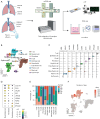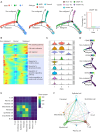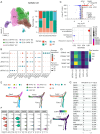Contribution of crosstalk of mesothelial and tumoral epithelial cells in pleural metastasis of lung cancer
- PMID: 38854934
- PMCID: PMC11157377
- DOI: 10.21037/tlcr-24-118
Contribution of crosstalk of mesothelial and tumoral epithelial cells in pleural metastasis of lung cancer
Abstract
Background: Tumor metastasis commonly affects pleura in advanced lung cancer and results in malignant pleural effusion (MPE). MPE is related to poor prognosis, but without systematic investigation on different cell types and their crosstalk at single cell resolution.
Methods: We conducted single-cell RNA-sequencing (scRNA-seq) of lung cancer patients with pleural effusion. Next, our data were integrated with 5 datasets derived from individuals under normal, non-malignant disease and lung carcinomatous conditions. Mesothelial cells were re-clustered and their interactions with epithelial cells were comprehensively analyzed. Taking advantage of inferred ligand-receptor pairs, a prediction model of prognosis was constructed. The co-culture of mesothelial cells and malignant epithelial cells in vitro and RNA-seq was performed. Epidermal growth factor receptor (EGFR) antagonist cetuximab was utilized to prevent the lung cancer cells' invasiveness. Spatial distribution of cells in lung adenocarcinoma patients' samples were also analyzed to validate our findings.
Results: The most distinctive transcriptome profiles between tumor and control were revealed in mesothelial cells, which is the predominate cell type of pleura. Five subtypes were divided, including one predominately identified in MPE which was characterized by enriched cancer-related pathways (e.g., cell migration) along evolutionary trajectory from normal mesothelial cells. Cancer-associated mesothelial cells (CAMCs) exhibited varied interactions with different subtypes of malignant epithelial cells, and multiple ligands/receptors exhibited significant correlation with poor prognosis. Experimentally, mesothelial cells can increase the migration ability of lung cancer cells through co-culturing. EGFR was the only affected gene in cancer cells that exhibited interaction with mesothelial cells and was associated with poor prognosis. Using EGFR antagonist cetuximab prevented the lung cancer cells' increased invasiveness caused by mesothelial cells. Moreover, epithelial mitogen (EPGN)-EGFR interaction was supported through spatial distribution analysis, revealing the significant proximity between EPGN+ mesothelial cells and EGFR+ epithelial cells.
Conclusions: Our findings highlighted the important role of mesothelial cells and their interactions with cancer cells in pleural metastasis of lung cancer, providing potential targets for treatment.
Keywords: Epidermal growth factor receptor (EGFR); epithelial mitogen (EPGN); mesothelial cells; pleural metastasis; single-cell dataset.
2024 Translational Lung Cancer Research. All rights reserved.
Conflict of interest statement
Conflicts of Interest: All authors have completed the ICMJE uniform disclosure form (available at https://tlcr.amegroups.com/article/view/10.21037/tlcr-24-118/coif). The authors have no conflicts of interest to declare.
Figures






Similar articles
-
Characterization of the pleural microenvironment niche and cancer transition using single-cell RNA sequencing in EGFR-mutated lung cancer.Theranostics. 2023 Aug 6;13(13):4412-4429. doi: 10.7150/thno.85084. eCollection 2023. Theranostics. 2023. PMID: 37649596 Free PMC article.
-
Single-cell transcriptomics reveal metastatic CLDN4+ cancer cells underlying the recurrence of malignant pleural effusion in patients with advanced non-small-cell lung cancer.Clin Transl Med. 2024 Apr;14(4):e1649. doi: 10.1002/ctm2.1649. Clin Transl Med. 2024. PMID: 38629624 Free PMC article.
-
Single-cell RNA sequencing and spatial transcriptome reveal potential molecular mechanisms of lung cancer brain metastasis.Int Immunopharmacol. 2024 Oct 25;140:112804. doi: 10.1016/j.intimp.2024.112804. Epub 2024 Jul 29. Int Immunopharmacol. 2024. PMID: 39079345
-
Pleural involvement in lung cancer.J Thorac Dis. 2015 Jun;7(6):1021-30. doi: 10.3978/j.issn.2072-1439.2015.04.23. J Thorac Dis. 2015. PMID: 26150915 Free PMC article. Review.
-
Cetuximab: an epidermal growth factor receptor chemeric human-murine monoclonal antibody.Drugs Today (Barc). 2005 Feb;41(2):107-27. doi: 10.1358/dot.2005.41.2.882662. Drugs Today (Barc). 2005. PMID: 15821783 Review.
Cited by
-
Serum β‑hCG as a prognostic marker for colorectal adenocarcinoma in women of reproductive age: A case report and literature review.Med Int (Lond). 2024 Nov 18;5(1):8. doi: 10.3892/mi.2024.207. eCollection 2025 Jan-Feb. Med Int (Lond). 2024. PMID: 39624467 Free PMC article.
-
Malignant pleural effusion is a negative prognostic factor for immunotherapy outcomes in non-small cell lung cancer: a single-center retrospective study.J Thorac Dis. 2025 May 30;17(5):3064-3072. doi: 10.21037/jtd-2024-1999. Epub 2025 May 13. J Thorac Dis. 2025. PMID: 40529739 Free PMC article.
-
A single-cell RNA-seq dataset of synovial fluid from rheumatoid arthritis treated with TNF-α/JAK inhibitor.Sci Data. 2025 Jun 10;12(1):977. doi: 10.1038/s41597-025-05339-4. Sci Data. 2025. PMID: 40494845 Free PMC article.
-
Decoding epithelial-fibroblast interactions in lung adenocarcinoma through single-cell and spatial transcriptomics.J Cancer Res Clin Oncol. 2025 Jul 24;151(7):221. doi: 10.1007/s00432-025-06250-6. J Cancer Res Clin Oncol. 2025. PMID: 40705084 Free PMC article.
References
LinkOut - more resources
Full Text Sources
Molecular Biology Databases
Research Materials
Miscellaneous
